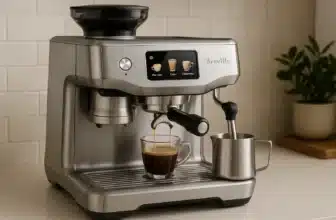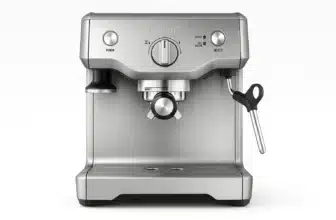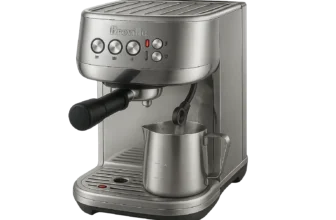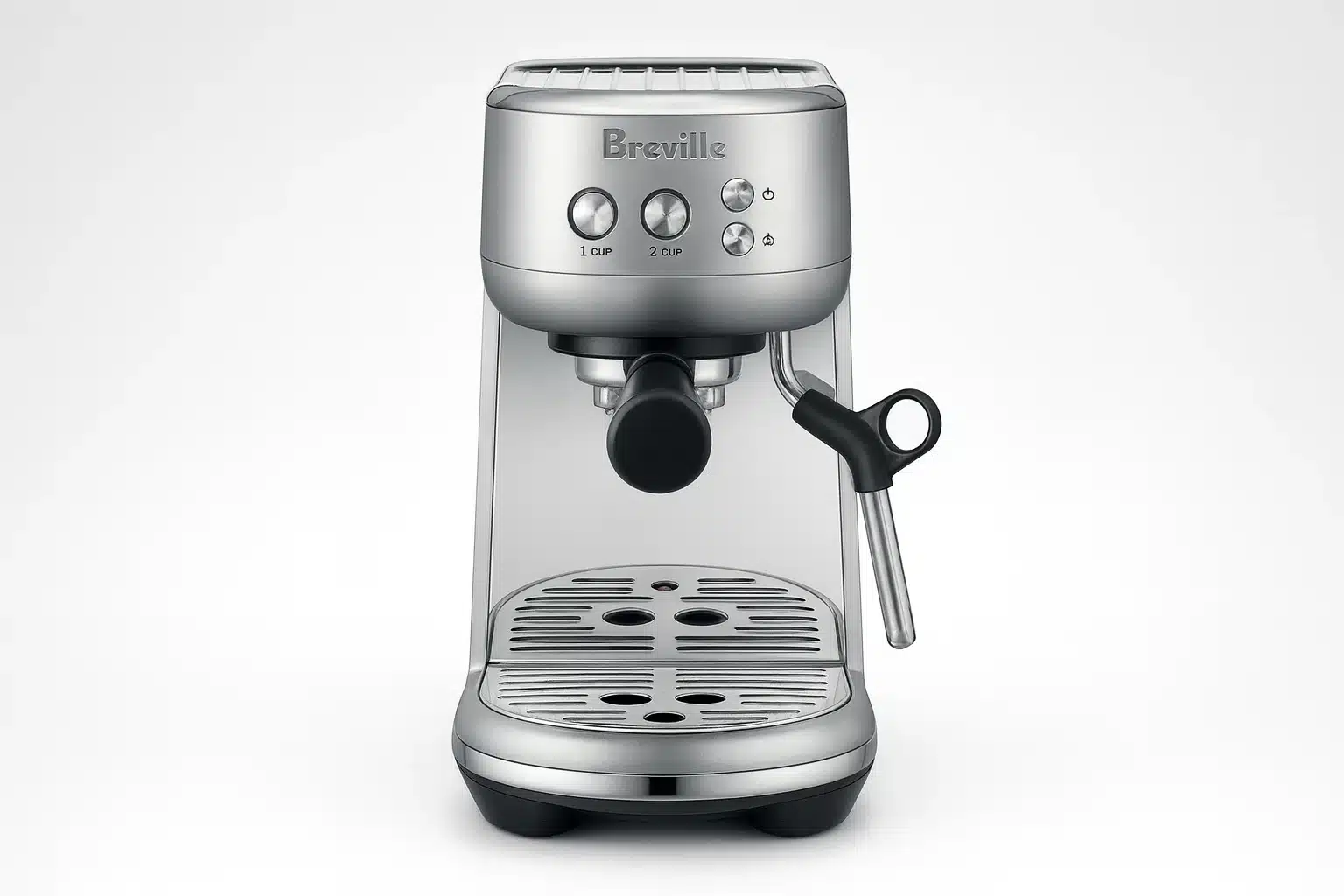
OneHundredCoffee is reader-supported, and some products displayed may earn us an affiliate commission. Details
Here’s the scene that sold me on the Breville Bambino: it was a weekday, I had 12 minutes before a video call, and I still wanted a proper espresso—not pod-coffee, not a rushed moka pot, not a sad pour-over. I hit the power button and, before my calendar reminder even chimed, the Bambino was hot. I ground, tamped, locked in, and pulled a syrupy shot that tasted like dark chocolate and orange peel. Then I steamed milk for a small flat white, and it all happened so quickly that I looked at the clock and laughed. I had time to sip.
That morning repeated itself—again and again—until I realized this little stainless-steel box had become the quiet center of my kitchen. The Breville Bambino (model BES450BSS) is compact, fast, and more capable than it looks. It won’t do everything for you (there’s no built-in grinder and no fancy screen), but it nails the fundamentals: stable heat, gentle pre-infusion, consistent water delivery, and a ready-to-go steam wand. If you’re wondering whether a compact machine can produce café-level espresso at home, the Bambino is proof that yes, with a halfway-decent grinder and a little curiosity, you absolutely can.

Breville Bambino Espresso Machine — Stainless Steel
Key Features
- Compact 2-second heat-up time with ThermoJet™ technology
- Low-pressure pre-infusion for smooth, balanced espresso extraction
- Manual steam wand for silky microfoam milk texturing
- Stainless steel body with minimalist footprint
- Automatic purge for precise temperature control
Why We Like It
The Breville Bambino packs barista-quality performance in a remarkably compact design. It heats up in just 3 seconds, delivers consistent espresso shots, and makes milk frothing feel effortless — perfect for small kitchens or apartment setups.
Pros
- Extremely fast heat-up time
- Compact, elegant design
- Produces rich crema with balanced extraction
- Excellent milk texturing capability
Cons
- Single boiler limits simultaneous steaming and brewing
- No built-in grinder
Bottom Line
A sleek, fast, and efficient compact espresso machine that delivers café-level espresso and microfoam at home — ideal for beginners and pros alike.
Price on AmazonHere’s our detailed review.
Who I Am & How I Tested
I’m the sort of coffee person who happily spends a Saturday dialing in a new bag of beans and also the sort of weekday human who needs coffee now. Over the last months, I ran the Bambino through daily shots—single origins and blends, light and medium roasts. I paired it mostly with a conical-burr grinder at home, used both pressurized and non-pressurized baskets, tried straight espresso, Americanos, cappuccinos, and flat whites, and handed the wand to friends to see how “first-try friendly” it felt. I cleaned it, descaled it, ignored it (briefly), and then made it up to the machine with a thorough backflush and a microfiber polish. What follows is the kind of review I wish I had when I was shopping: patient, practical, and honest about where the Bambino shines—and where it asks a little more from you.
Size & Design: Small Footprint, Big Energy
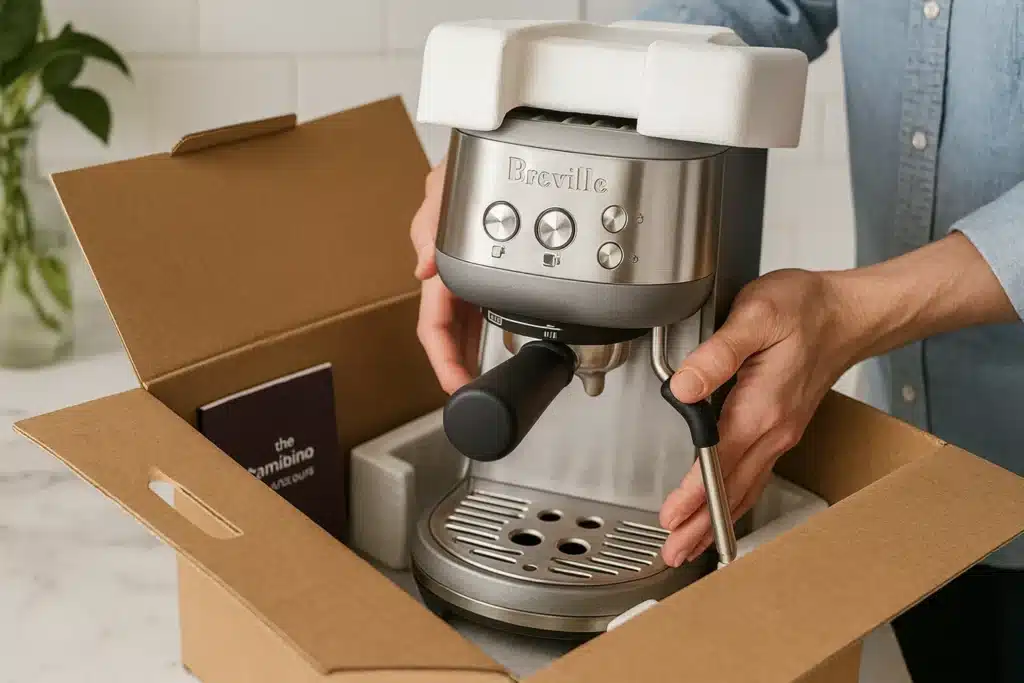
The first time I unboxed the Bambino, I thought, That’s it? It’s narrower than a loaf of bread and shorter than a standard kettle. The footprint matters more than you think. I’ve lived with larger espresso machines that dominated the counter and made everything around them sticky. The Bambino has “apartment energy”: it tucks into tight corners, slides out easily for cleaning, and leaves enough space for a scale, grinder, and knock box without turning your prep area into a barista obstacle course.
The front face is clean: a polished stainless-steel body, simple button layout, centered group head, and that classic Breville drip tray with a red “empty me” indicator when it fills. The portafilter handle has a reassuring weight, and nothing rattles or feels toy-like. Even the cup-warming deck—small, but useful—has enough room for two demitasses.
Living with the size day-to-day: I can set up, pull a shot, steam milk, and wipe down without the back-and-forth shuffle that bigger machines create. The compactness encourages tidiness, and because it’s light, I can easily pivot it to top up the water or to wipe behind the machine. It’s the kind of form factor that actually gets used every day because it never feels like a project.
A Quick Look at Our Top Breville Picks Under $500
| Image | Product | Features | Price |
|---|---|---|---|
Best Compact Espresso Machine  |
| Price on Amazon | |
Compact Barista-Quality Espresso  |
| Price on Amazon | |
Professional Dual Boiler Espresso  |
| Price on Amazon | |
Best Semi-Automatic Espresso Entry  |
| Price on Amazon |
Colors & Finish: Stainless That Plays Nice With Your Kitchen
The BSS in BES450BSS signals the Brushed Stainless Steel finish. In person, it’s more matter than mirror—thank goodness. It hides fingerprints remarkably well and matches the “stainless but not flashy” look of modern appliances. The corners are softened just enough that it reads “friendly” rather than “industrial.” If you’ve ever had a harsh, mirrored machine that demanded a polish after every use, you’ll appreciate how forgiving the Bambino’s finish is.
After several months, mine still looks new. Occasional splashes around the steam wand wipe clean with a damp cloth; a quick buff with a dry microfiber brings back that smooth satin sheen.
User Interface: Buttons You’ll Actually Use
No screens. No menus. Just the essentials: single shot, double shot, steam, hot water, and power. That’s it. The brilliance of the Bambino’s interface is that it makes espresso feel like muscle memory:
- Tap power → the machine is ready almost immediately.
- Tap single or double → pre-infusion begins, then the machine ramps to full pressure.
- Tap steam → the wand is ready in a blink for milk.
The shot buttons are programmable if you want to set custom volumes. I did this once to tailor my double to ~36–40g out and then left it alone. The machine listens to you: start/stop on demand, and if you prefer timing shots manually, you can. There’s no complicated dance; nothing to scroll; no hidden modes you’ll forget.
For beginners: this is an interface that invites experimentation without intimidation. You’re not forced into “factory espresso” any more than you’re left without guidance. The pre-infusion is automatic, and the default volumes are sensible, which means you can get a good shot and then improve it over time.
Water Tank: Bigger Than It Looks, Easy To Live With
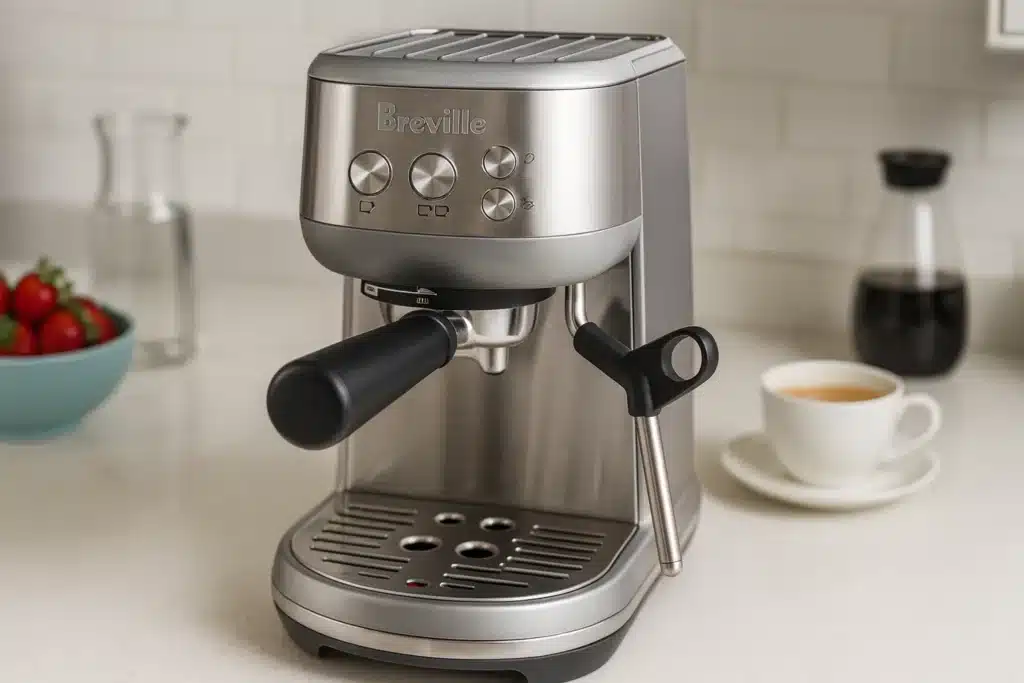
For such a compact machine, the rear water tank is generous enough that I can pull several doubles and steam milk multiple times before refilling. It lifts out easily, has a handle, and seats with a positive click, so you never feel like you’re guessing about alignment. I keep a small pitcher near the sink and top it up every other day. If you have very hard water, using filtered water will keep the scale down and extend the time between descaling. The tank’s transparency makes it obvious when you’re low—a glance from above is enough.
Day-to-day habit: I got into the routine of filling on Sunday night and then just topping off mid-week. No drama, no buried valves, no fiddly caps.
Coffee Grinder (External): The Bambino’s Best Friend
Important: the Bambino does not include a built-in grinder. That’s not a flaw—it’s a design choice that I ended up loving. Separate grinder = better espresso. Why? Grind quality and adjustability matter more than almost any other variable once you have a stable machine.
I used two burr grinders while testing. With a solid burr grinder, the Bambino produces shots that punch far above its weight. With a mediocre grinder, you’ll still get drinkable espresso—especially if you start with the pressurized (dual-wall) baskets—but you’ll hit a ceiling quickly. If you’re buying the Bambino, plan for a capable burr grinder. It’s the single upgrade that turns “good for the price” into “this is legitimately great.”
My routine: I weigh beans (18g for a double basket is a nice starting point), grind fresh, distribute with a simple WDT tool (thin needles break up clumps), and tamp level. When the grinder is dialed in, the Bambino rewards you with silky, consistent extractions.
Portafilter & Baskets: 54mm, Friendly, and Flexible
Breville uses a 54mm portafilter on the Bambino. It’s lighter than some commercial 58mm setups but feels sturdy, and the handle angle sits naturally in the hand. Depending on your market, you’ll get both pressurized (dual-wall) and non-pressurized (single-wall) baskets. The dual-wall baskets are forgiving—they boost resistance and help create faux-crema even if your grind is a bit off. Great for day one. But the magic happens with single-wall baskets and a good grinder. That’s when you’ll taste clarity, layered sweetness, and real crema.
Lock-in is smooth and confident; there’s no awkward hunting for the grouphead groove. The spouts are centered and tidy—no odd drips down the side of the cup when your tamp is level.
Automatic vs. Manual Dose: The Control You Want, The Help You Need
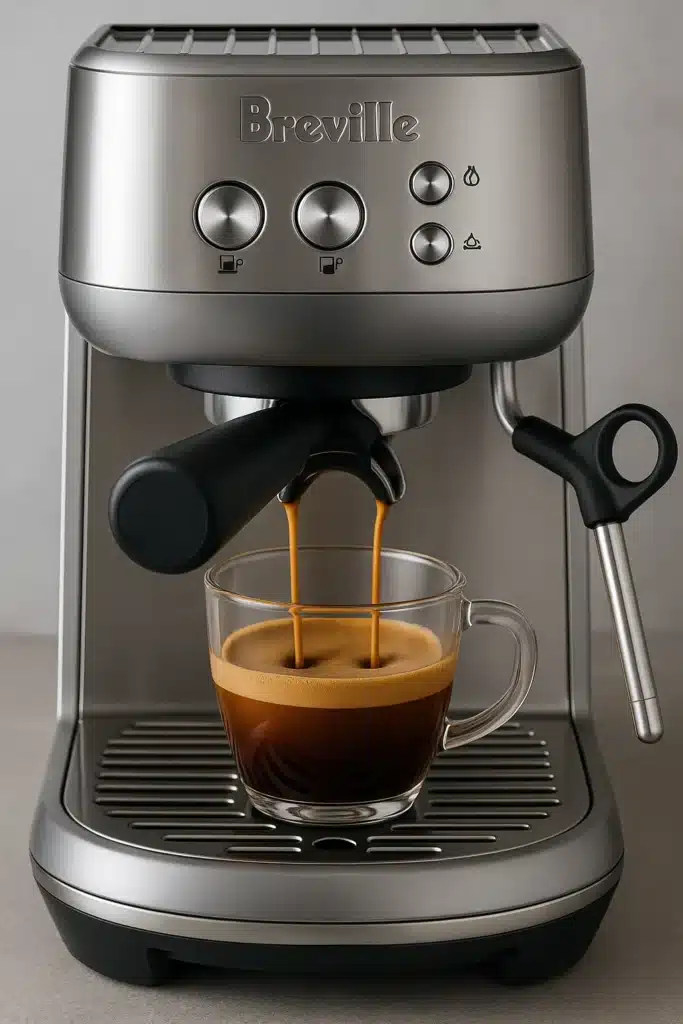
Out of the box, the single and double buttons are pre-set to reasonable volumes. If you want a tighter ristretto or a longer normale, you can reprogram them by starting a shot and stopping it where you’d like the machine to remember. I tried this for a classic 1:2 ratio (e.g., 18g in, ~36g out) and then spent a week switching back and forth with manual timing. In the end, I landed on manual timing so I could adjust to different beans without touching the programming—tap to start, watch the flow, tap to stop. The Bambino is happy either way.
What it feels like: The machine’s logic gets out of your way. You choose your style: fully manual timing, or a “push and pour” routine that’s consistent enough for busy mornings.
Pre-Infusion & Heating System (ThermoJet): Where the Bambino Punches Above Its Class
The Bambino’s vibe can be summed up in two words: ThermoJet and pre-infusion. The ThermoJet heating system warms up in mere seconds, which seems like a party trick until you’ve lived with it. The real benefit is momentum: you’re not standing around. You grind, you lock in, you brew. Shot after shot, the temperature is stable enough that you don’t have to wait or flush or chase a sweet spot.
Pre-infusion starts each shot with a gentle soak that evens out the puck before full pressure arrives. In the cup, this shows up as fewer channeling headaches and a more consistent flavor. On light roasts, pre-infusion helps bring out florals and sugar-sweet acidity; on medium roasts, it smooths edges and makes dialing in feel less dramatic. It’s the feature that makes the Bambino feel forgiving without dumbing anything down.
Cup Sizes & Clearance: Espresso, Cortado, and Small Lattes
There’s enough clearance for standard espresso cups and most small latte/cappuccino cups. If you like tall mugs, pull out a shot glass and transfer, or pop off the drip-tray top for a little extra height. I usually pull doubles into a short glass and then top with hot water for an Americano or with steamed milk for a modest flat white.
Cup-warming tray: It’s petite, but it works. I keep two demitasses up top. Pre-warming cups (or at least rinsing with hot water) is an easy flavor upgrade; the Bambino encourages that habit by making the cups feel close at hand.
Tamping: Simple, Satisfying, and Worth Getting Right
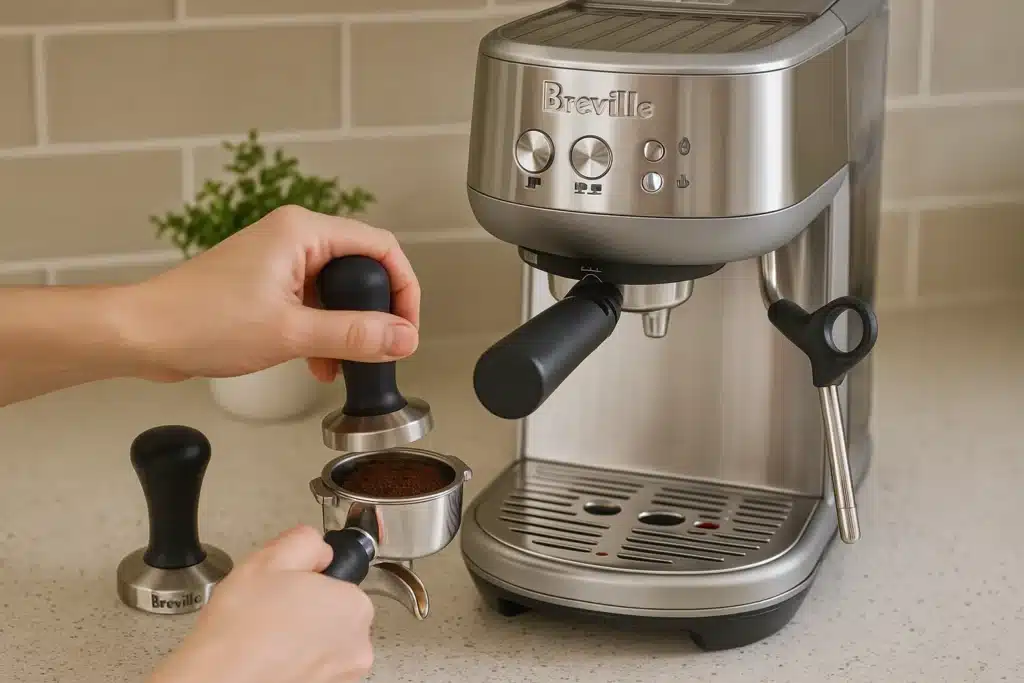
Good tamping solves half of the problems beginners run into. With the Bambino’s 54mm baskets, a properly sized tamper makes a world of difference. The machine ships with a basic tamper in some regions; I swapped to a heavier one and immediately noticed more consistent flow. Keep it level, use firm but not aggressive pressure, and don’t polish your tamp like you’re buffing a car—just press, lift, lock in.
Distribution matters: If you grind fine for espresso, you’ll get clumps. A $10 WDT tool (thin needles you swirl through the grounds) evens the bed and nearly eliminates spurts or channeling. The Bambino rewards this tiny step every time.
Temperature Control & Stability: Quietly Competent
There’s no front-facing temperature readout or degrees to set, but that doesn’t mean the Bambino is guessing. In daily use, shots taste consistent: no sour “underheated” vibe on the first shot, no scorched bitterness on the second. I like how the machine automatically purges a touch after steaming, bringing the group back toward brew temperature. If you’re coming from an older single-boiler machine that needs a whole flushing dance, you’ll feel the difference right away. The Bambino behaves—predictably.
If you want to nudge flavor warmer or cooler, do it via shot time and yield rather than hunting phantom temperature settings. Grind slightly finer or coarser, adjust the dose by a gram, or let the shot run a couple of seconds longer. The Bambino communicates clearly in the cup.
Milk Frothing & Steam Wand: Microfoam On Demand
Steaming is where many compact machines fall apart. Not here. Tap steam and the wand is ready in moments—no long wait after brewing. The wand has straightforward power and a learning curve that’s measured in minutes, not weeks. Angle the pitcher, keep the tip near the surface to introduce air, then sink slightly to roll. The result? Glossy, pourable microfoam that plays beautifully with espresso, even on a small drink.
Latte art reality check: With a bit of practice, I could pour hearts and tulips consistently. The steam is not “fire hose” strong like on big commercial machines, but that’s actually helpful at home—it gives you time to position, stretch, and texture. For cappuccinos, it’s easy to make denser foam without drifting into bubbly bath-suds land.
Cleanup: A quick purge and a wipe. The wand’s outer surface wipes clean without milk baked on.
Cleaning & Maintenance: Low Effort = High Compliance
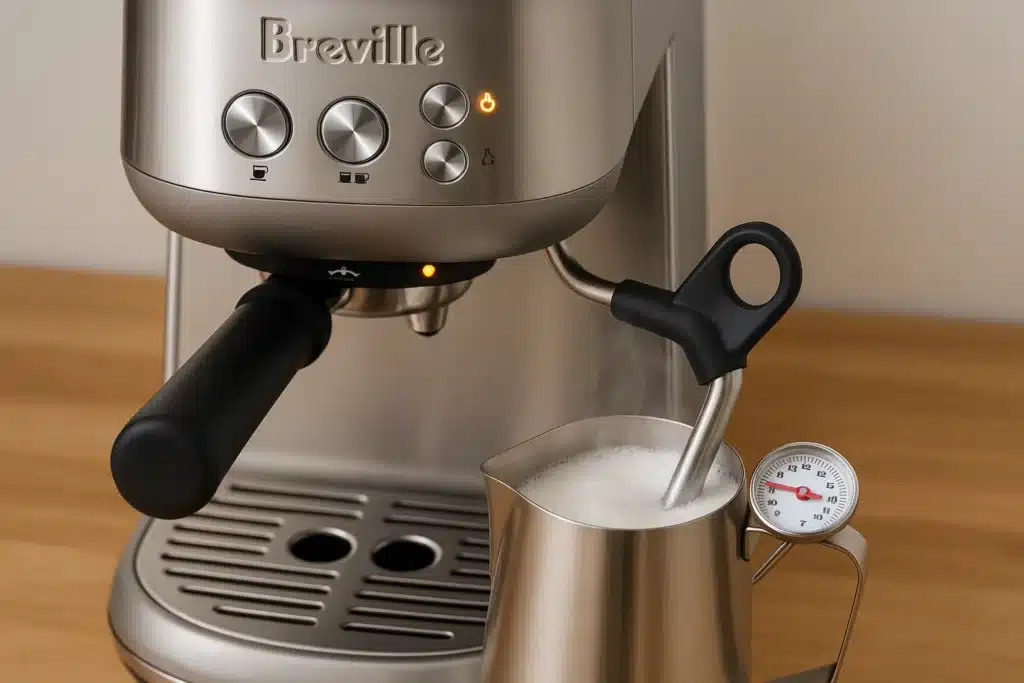
This is the first espresso machine I’ve owned where I actually clean it as often as I’m supposed to. The drip tray slides out with a satisfying click. The “empty me” float is a cute nudge that’s visible at a glance. Backflushing with cleaning tablets is straightforward (follow the manual cadence), and descaling is as drama-free as descaling gets. I rinse the portafilter and baskets right after brewing—habit is everything—and the machine rewards that tiny effort with months of no fuss.
Noise & Speed: Kitchen-Friendly
The pump hum is modest, and steaming is a steady whoosh—neighbors won’t know you’re making a cortado at 6 a.m. The real story, though, is speed. From cold to brewing in a few heartbeats; from espresso to steam with barely a pause. That tempo changes how you use the machine. I started making “one more quick shot” on weekends just because I could.
Reliability & Build: Light, But Not Flimsy
The Bambino is not a 40-pound brass monument, and I don’t want it to be. It’s sturdy where it counts: the grouphead locks confidently, the buttons don’t wobble, the steam knob feels crisp. After months of daily use, nothing has loosened, plastic hasn’t yellowed, and the finish still looks fresh. If you take care of it—wipe, purge, descale on schedule—it feels like a machine that will happily live on your counter for years.
What Surprised Me Most
- How forgiving it is with pre-infusion: even on a rushed morning tamp, the shot was still balanced.
- How often I steamed milk because it was so fast to get ready. I drank more cappuccinos in a month than I had in the previous year.
- How much the grinder defines the ceiling. The Bambino is good enough that a better grinder is obvious in the cup. That’s a compliment.
Drawbacks & Limitations (So You’re Not Surprised)
- No built-in grinder. Not a flaw to me, but it’s an extra purchase if you don’t already have one.
- 54mm ecosystem. It’s common, but 58mm accessories are more plentiful. That said, I found everything I needed—precision baskets, tampers, WDT—without hunting.
- No advanced temperature settings or shot profiling. If you want obsessively granular control or a pressure gauge, you’ll move up the line (and up in price).
- Cup clearance for tall mugs. The workaround is easy, but worth mentioning.
None of these were deal-breakers for me. They’re the trade-offs that keep the Bambino compact, fast, and approachable.
Tips for Café-Level Results on the Bambino
- Invest in a burr grinder. Dial-in is 80% of espresso.
- Start 18g in, 36–40g out, ~25–32 seconds from first drip. Adjust to taste.
- Use single-wall baskets once you’ve got your grinder tuned; dual-wall for training wheels or older beans.
- WDT + level tamp. Cheap tools, major consistency.
- Purge and wipe the steam wand immediately after use. Future-you will be grateful.
- Use filtered water if your tap water is hard; scale is the enemy of heat and flow.
Real-World Recipes I Loved
- Double Espresso (chocolate-forward medium roast): 18g in → 38g out in ~28s. Syrupy, cocoa, and orange zest finish.
- Flat White: Same shot, 120–140ml milk, steam just to velvety microfoam. Glossy, sweet, balanced.
- Americano: 18g in → 36g out, then hot water to 6–8oz total. Silky without bitterness.
Comparison: How the Bambino Stacks Up
| Machine | Who It’s For | Strengths | Trade-offs |
|---|---|---|---|
| Breville Bambino (BES450BSS) | Beginners to enthusiasts who want fast heat and real espresso in a small footprint | Tinkerers who want a tank-like single-boiler with a 58mm standard | No built-in grinder; limited advanced controls |
| Breville Bambino Plus (BES500) | Milk-drink lovers who want auto-steam temperature/texture | Auto milk texturing, slightly more cup-friendly deck | Costs more; still no built-in grinder |
| Gaggia Classic Pro | Heavy-duty build, 58mm ecosystem, mod-friendly | Heavy duty build, 58mm ecosystem, mod-friendly | Longer warm-up, learning curve for temp surfing |
| De’Longhi Dedica Arte | Ultra-compact kitchens, occasional milk drinks | Slim profile, easy to use | Narrower headroom for top-tier shots; lighter steam |
| Breville Barista Express | All-in-one buyers | Built-in grinder, “one-box” convenience | Grinder is decent but not top-tier; larger footprint |
My take: If you already own (or plan to buy) a good grinder, the Bambino is the most “effortless-to-excellent” path to home espresso in its price/size class. If you make milk drinks daily and want automation, the Bambino Plus is tempting. If you love to mod and tinker, the Gaggia Classic Pro is your playground.
Customer Guide: Buying, Setup & Daily Use
1) Do You Need a Separate Grinder?
Short answer: yes—a good one. Espresso is unforgiving of poor grind quality. Prioritize a burr grinder with fine, consistent steps (or stepless adjustment). If your budget is tight, I’d rather pair the Bambino with a strong grinder than buy an all-in-one compromise.
2) What Beans Work Best?
Medium roasts shine: chocolate, caramel, and nutty profiles are easy to dial and pair beautifully with milk. Light roasts work too—expect finer grinds and possibly longer shots to coax sweetness.
3) How Do You Dial In?
- Start 18g dose, aim 36–40g yield, 25–32 seconds.
- If sour/under, grind finer or increase yield slightly.
- If bitter/over, grind coarser or shorten the yield/time.
- Taste, adjust one variable at a time, and take notes.
4) Water, Descaling & Filters
Use filtered water if possible. Descale on schedule (your water hardness will set the cadence). The cleaner the machine, the more consistent the cup.
5) Milk Frothing Basics
Purge, stretch milk for a few seconds (gentle “paper tearing” sound), then sink the tip to roll. Stop when the pitcher is hot to the hand but not screaming. Immediately purge and wipe the wand.
6) Essential Accessories
- 54mm precision basket and tamper that fits snugly
- WDT tool (cheap, game-changing)
- Small scale (to weigh dose and yield)
- Milk pitcher sized for your drink
- Knock box (keeps counters tidy)
7) Troubleshooting Quick Map
- Gushers/thin shots: grind finer, tamp level, check basket size.
- Choking/no flow: grind coarser, lower the dose by 1g, watch for over-tamping.
- Sour: warmer flavors = finer grind or longer shot.
- Bitter: cooler flavors = coarser grind or shorter shot.
My Daily Routine (What It Actually Looks Like)
- Power on. The machine’s ready by the time I’ve weighed 18g.
- Grind → quick WDT → level tamp.
- Lock in, scale under cup, tap double (or start/stop manually).
- While the shot runs, I pour milk and prep the pitcher.
- Tap steam, texture milk, wipe, and purge.
- Drink, smile, rinse baskets, empty tray at night.
On weekends, I slow down and play with lighter roasts or different ratios. On weekdays, I appreciate that it never argues with me.
Frequently Asked (Really) Questions
Can the Bambino make true microfoam?
Yes. With a little technique, you get glossy, paint-like microfoam suitable for latte art. The steam power is balanced—home-friendly rather than aggressive.
Is the 54mm portafilter a problem for accessories?
Not in my experience. There’s a healthy ecosystem of baskets, tampers, distributors, and WDT tools sized for 54mm Breville machines.
Do I need to reprogram the shot buttons?
You don’t have to. The defaults are sensible. I timed shots manually most days and only used programming when I wanted a “set-and-forget” ratio for family members.
What about temperature?
There’s no external PID to adjust, but the machine is internally smart and consistent. If you’re chasing ultra-specific temperatures for experimental light roasts, you’ll want a higher-end setup. For everyday espresso, this is more than stable enough.
How long is warm-up, really?
Functionally instant. By the time you’ve locked a portafilter and placed a cup, it’s go-time.
A Week of Shots: Tasting Notes
- Brazil-heavy blend: Fudge brownie, almond, low acidity. Perfect flat white base.
- Ethiopian natural: Strawberry jam and jasmine when I let the shot run to 40g. Magic in a cortado.
- Colombian washed: Orange peel, caramel, hazelnut. Balanced and forgiving—my daily driver.
What I loved most was that the Bambino lets the coffee talk. It doesn’t impose a house flavor; it translates what your grinder and beans are telling it to say.
The Part Where I Admit My Bias (And Why)
Tiny machines used to make me suspicious. I’ve fought with compact, under-heated boilers and wand-like steamers that hiss more than steam. The Bambino changed my mind. It keeps enough of the “real machine” DNA—pre-infusion, fast and stable heat, honest steam—while removing the friction. I don’t have to warm up for fifteen minutes, I don’t have to flush dance, I don’t have to make excuses for it. I just make espresso.
Who Should Buy the Breville Bambino (BES450BSS)?
- You want café-level espresso at home without dedicating half your counter or your entire paycheck.
- You’re willing to pair it with a real grinder (do it—you’ll thank yourself).
- You make 1–4 drinks a day, split between straight espresso and small milk drinks.
- You prefer simple buttons over screens and settings.
If that’s you, the Bambino feels custom-built for your mornings.
Who Should Consider Something Else?
- Daily large milk drinks, auto-texturing, and “set it and forget it”? The Bambino Plus might fit better.
- Tinkering and modding with a classic 58mm platform? Gaggia Classic Pro is your playground.
- One box, no separate grinder (despite the trade-offs)? Consider a Barista Express-type machine.
Final Verdict (Personal)
After months with the Bambino, I keep reaching for it because it respects both sides of my coffee personality: the enthusiast who loves dialing in and the person who oversleeps. It’s small, fast, gentle with the puck, and fearless with milk. It forgives a rushed tamp and still rewards a meticulous prep. Most importantly, it makes me want to make espresso on busy Tuesdays and slow Sundays alike.
If you’re ready to step into real espresso at home without turning your counter into a science project, the Breville Bambino BES450BSS is the machine I’d buy again. Pair it with a good grinder, treat it with a little care, and it will pay you back every morning with a cup that tastes like you did something nice for yourself—because you did.
TL;DR
- Pros: Instant heat, real pre-infusion, excellent steam, compact, simple UI, reliable results.
- Cons: No built-in grinder, limited advanced controls, 54mm ecosystem (still plenty of accessories).
- Buy it if: You want café-level espresso in a small, friendly package and already own (or will buy) a good burr grinder.
Quick-Start Recipe Card (Save This)
- Dose: 18g (double basket)
- Yield: 36–40g
- Time: 25–32 seconds from first drip
- Milk: Stretch for ~3–5 seconds, then roll to microfoam
- Tips: WDT, level tamp, purge/wipe wand immediately, use filtered water
Here’s our detailed review—and here’s the simple truth: this little machine made my mornings better. That’s the kind of spec you won’t find on a box, but it’s the one that matters most.



